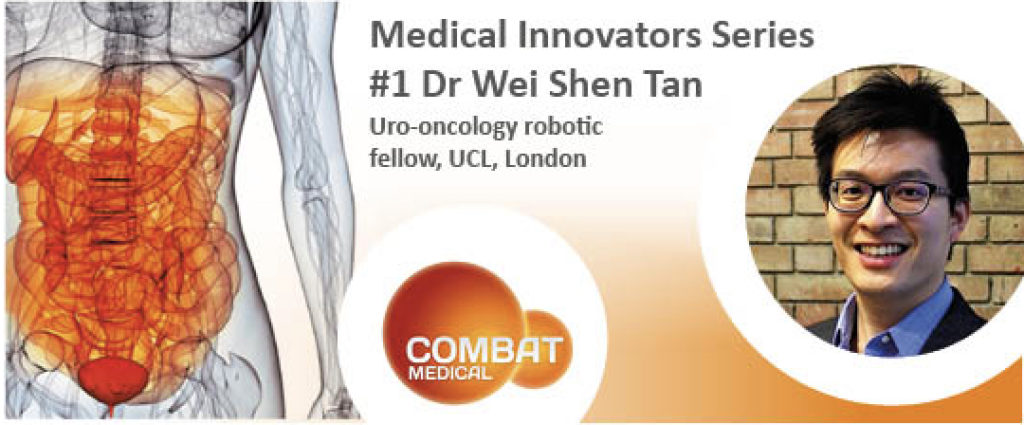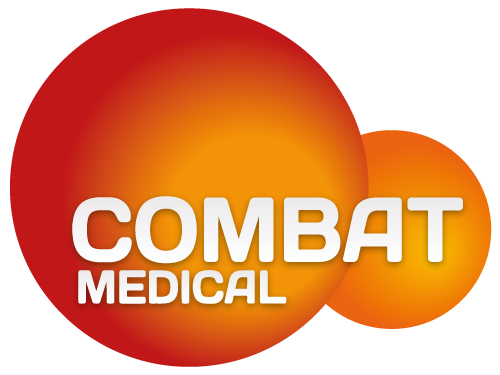
Welcome to Combat Medical’s first Medical Innovators interview series, where we’ll be exploring ideas and developments in the medical and clinical worlds with the people at the, ahem, cutting edge. To kick off, we’re talking haematuria, urine biomarkers and novel bladder-cancer therapies for BCG-unresponsive patients with Dr Wei Shen Tan, uro-oncology robotic fellow at University College Hospital, London, and incoming Society of Urologic Oncology (SUO) fellow at the University of Texas MD Anderson Cancer Center – recently ranked first for cancer care in the US.
Dr Tan, why did you choose a medical career and urology in particular?
Medicine is something I’ve always been passionate about. After my BSc at UCL and medical school at Cardiff University, I subsequently moved to London, where I have been an academic trainee for the last decade or so and completed a PhD in uro-oncology at UCL. I’m particularly passionate about urology. I like the fact we get to help people every day and that it combines medicine with surgery – fascinating surgery, such as robots and other new toys [laughs], including innovative medical treatment devices.
Well, the robot was supposed to be a wonderful tool for the cranial neurosurgeons before the urologists stole it, so you’re in a very innovative area. Do you ever lend yours to cardiothoracics?
Yeah, sometimes [laughs]. We actually share them with cardiothoracics at UCLH. But robots are predominantly used by urologists these days.
What do you focus your research efforts on?
I am passionate about bladder cancer, particularly in hyperthermia treatment, optimising outcomes following robotic cystectomy and cancer diagnostics. My PhD focused on optimising the investigation of haematuria and bladder cancer. We recruited over 3000 patients across 50 hospitals throughout the UK for a prospective observational study trying to validate a urine biomarker, so we captured the incidence of haematuria and of cancers in patients with haematuria. We also looked at different types of bladder-cancer investigations and reported that using ultrasound scans rather than CT in patients with non-visible haematuria is safe and would avoid radiation in a substantial number of patients.
More recently, I’ve been working on a nomogram approach to better select patients for investigation following a presentation of haematuria. I’ve also done mixed-method, qualitative interviews to assess patients with non-muscle invasive bladder cancer (NMIBC) using a urine-based biomarker for surveillance, and interrogated patients’ feelings and opinions following bladder-cancer diagnosis.
At the DGU21 urology congress in Stuttgart last month there were a number of companies with urinary biomarker bioassays, but this doesn’t yet seem to be a mainstream area. Given that it’s a non-invasive diagnostic, potentially even a bedside tool, where do you see this going?
There are certainly lots of companies making urine biomarkers, but I think it’s important to define how such biomarkers might add information in terms of your decision-making and what you would expect from it. First of all, there should be a clear demarcation between patients being investigated for haematuria and those on NMIBC surveillance. With haematuria, the problem is that this is a one-off investigation, and with a urine biomarker it can be difficult to assess how accurately you can rule out the presence of cancer – there are so many variables to take into account, such as perhaps not having enough DNA from your urine sediment, or that a low-grade tumour may be present but unidentifiable via urine biomarker.
In the haematuria setting, you want to be quite specific about the target audience for your urine biomarker. For elderly male smokers with visible haematuria, there’s minimal benefit in using a urine biomarker. They should proceed straight to cystoscopy and imaging, because even if the urine biomarker comes back as negative, these guys are at high risk of having tumours – one might not necessarily trust the result of the urine biomarker, which currently does not have a sensitivity to match cystoscopy.
So I feel the role of the urine biomarker would probably be with low-risk patients with non-visible haematuria – the non-smokers, women, those who are relatively young. In an adequately counselled patient, you could potentially use the urine biomarker in combination with an ultrasound scan, and possibly negate the requirements for cystoscopy and CT imaging, especially for first presentation. And this is where I see that a nomogram approach, using clinical and genomic biomarkers in combination with the urine biomarker, would be beneficial.
Imagine you’ve found a DeLorean in the car park and jumped five years into the future, where those companies currently developing the biomarker assays have finally come up with the perfect diagnostic tool for everyday urology. For you, what would it be?
In terms of a urine biomarker, the one with the highest sensitivity might not necessarily be the clear champion. It needs to be quick and simple to use, with results that can be turned around fast and easily interpreted by the clinician. The non-visible haematuria, low-risk patients would probably be the best ones to use it with because their incidence of tumour is low.
Do you think it would still be a laboratory test that people have to wait two days for, or do you think every GP in the country will have a dipstick for bladder cancer next to their dipstick for ketosis?
No, I don’t think it’s going to go that way. I think it’ll be centralised facilities in hospitals. The urine samples would be sent to hospital, similar to arranging for a blood test, and with a turnaround time roughly similar. Individual GP practices would see maybe one or two haematuria patients in a week, but the hospital would cater for the whole community of GP services, and that would make the economies of scale more favourable.
We get it – you don’t want the GPs stealing all your patients.
[Laughs] No, I would say it’s important to try to keep patients at the primary-care level where possible. GPs would send off the urine samples to a facility and, provided they’ve got adequate training in counselling patients regarding the results, that would work well as a system.
How might this five-year scenario look for high-risk patients like 75-year-old male smokers, compared to today?
In the UK, the pathway for high-risk groups means they are seen within two weeks for investigations – it’s a great service and a testament to the NHS. Hopefully, we can continue providing this high quality service for patients, so the role of a urine biomarker would probably be less useful for this group.
We currently have national PSA screening for the over-50s. Do you see a similar scheme coming in for bladder cancer in the next five years?
I think not. With bladder cancer, we’re very fortunate to have the cardinal sign of haematuria as a triage tool. It’s unlikely you would investigate somebody in the absence of haematuria, although there are patients picked up coincidentally who present with bladder cancer in the absence of haematuria. I certainly don’t foresee that we’ll be grabbing people on the streets and doing cystoscopies on them any time soon.
Robot-assisted surgery has revolutionised urology in the last ten years or so. Imagine you’ve just been given £1 billion of venture capital – what revolutionary innovation would you want to come up with?
That’s a lot of money [laughs]. I would actually split it into several different projects, including a biomarker. Ideally, in the absence of commercial interests, I’d want to test all the different biomarkers, combining them with clinical and genomic classifiers in a prospective study to see which one pans out the best. I’d also do the same in an NMIBC setting to see whether any of these biomarkers can predict who is likely to get recurrence and whether there is a signal we could use instead of cystoscopy.
Another area of bladder cancer where treatment is currently limited is the BCG-unresponsive group of patients. There are different treatment options at the moment, including FDA-approved pembrolizumab – but it’s very costly and is not without the risk of major adverse events, which can be lifelong compared to localised treatments such as installations and device-assisted therapies. There’s definitely a lot more work to be done in this field.
Now forget about that billion (hard, we know), but instead please accept a Combat Medical magic wand that enables you to immediately change one thing in urology. What would it be?
Well, I’m biased because I’m very interested in bladder cancer, but I do think it’s sad that survival rates for muscle-invasive bladder cancer have remained pretty poor over the last few years, despite the role of chemotherapy and, more recently, immunotherapy. There is a dire need for more treatment options for muscle-invasive bladder cancer patients. I’m hopeful, though, that advances in medical sciences will improve this situation. Surgery is likely to be part and parcel of a multimodality approach – combining it with systemic-treatment options and new target therapies.
You’re about to take on a new role in Houston, Texas as SUO fellow at the MD Anderson Cancer Center – so you’re well on your way as an academic, a surgeon and a clinician. Who has inspired you as you’ve moved through your career path?
There are two people in particular that I’d have to nominate. Professor John Kelly at UCL nurtured me as an intern and subsequently provided me the opportunities to develop as an independent researcher. I must credit a lot of my academic development and research opportunities to him. I did my PhD under his supervision, and had the opportunity to work on a few randomised controlled trials and biomarker validation studies. For the last decade he’s been a great mentor, very supportive, and providing me with opportunities to flourish.
I’m also very fortunate to be working with Ashish Kamat in Texas – he’s another great urologist and a brilliant academic. We’ve been working on a grant together recently and he has been incredibly helpful and supportive. I’m really looking forward to working with him more when I move over there next year.
Dr Tan, many thanks for being such a terrific first guinea pig interviewee – and good luck with your transatlantic move.
If you’d like to share your own ideas and opinions as a fellow medical innovator, please message or drop Guy Cooper an email at grc@combat-medical.com

